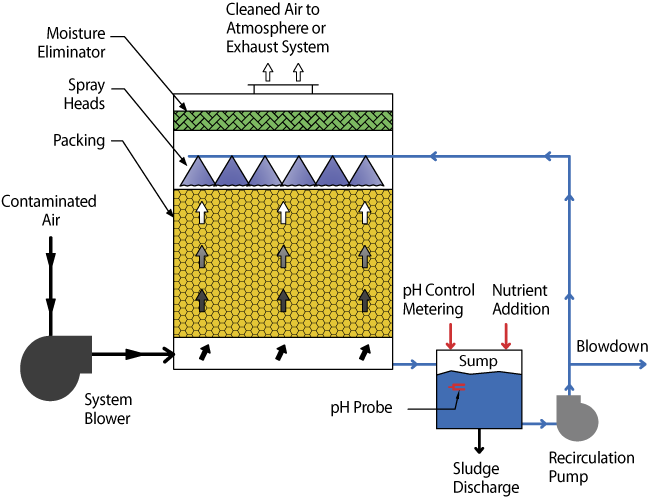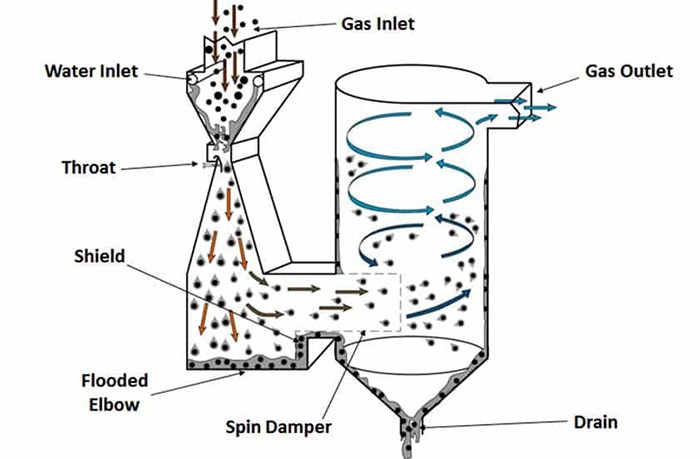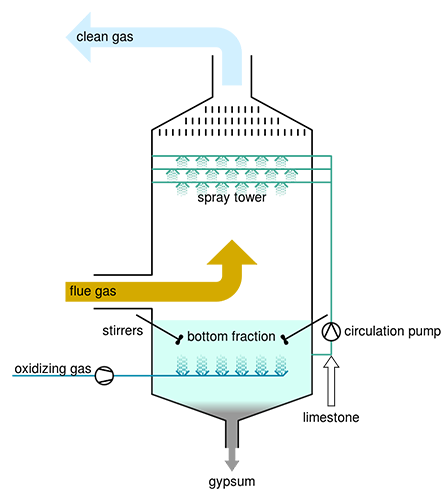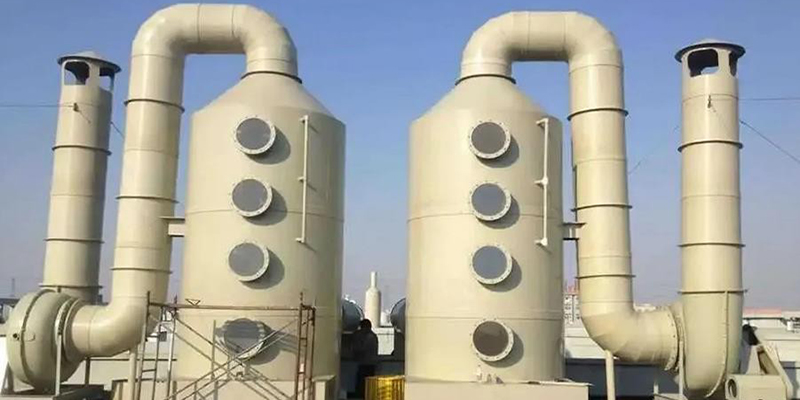Wet scrubbers are air pollution control devices that utilize a liquid (usually water or chemical solution) to remove pollutants from industrial gas streams. They operate on the principle of gas-liquid contact, where the contaminated gas passes through a scrubbing chamber or vessel, coming into intimate contact with the scrubbing liquid. This contact facilitates the removal of pollutants through various mechanisms, including absorption, adsorption, chemical reaction, or physical impaction. Here’s an overview of different types of wet scrubbing systems:
Packed Bed Wet Scrubbers
Design:
Packed bed wet scrubbers consist of a cylindrical vessel filled with packing material, typically made of plastic or ceramic. This packing material provides a large surface area for gas-liquid contact, enhancing pollutant removal efficiency. The scrubbing liquid is introduced into the scrubber either countercurrently or cocurrently with the gas stream, allowing for effective absorption, adsorption, or chemical reaction of pollutants.
Operation:
Contaminated gas enters the bottom of the scrubber and ascends through the packed bed, while the scrubbing liquid is introduced from the top and descends through the packing material. Gas-liquid contact occurs as the gas stream passes through the packing material, enabling pollutants to be captured by the scrubbing liquid. The packed bed facilitates mass transfer between the gas and liquid phases, providing ample surface area and residence time for efficient pollutant removal.
Applications:
Packed bed wet scrubbers find wide-ranging applications in industries requiring the removal of particulate matter, acidic gases, and odorous compounds from gas streams. They are commonly used in chemical processing plants, metal refining facilities, wastewater treatment plants, and pulp and paper mills. Packed bed scrubbers excel in the removal of fine particulates and soluble gases, making them suitable for applications with stringent emission regulations.
Advantages and Considerations:
Packed bed wet scrubbers offer several advantages, including high efficiency in pollutant removal, versatility in handling various pollutants, and relatively low operating costs. However, they may require periodic maintenance to prevent fouling or clogging of the packing material, necessitating regular inspection and cleaning. Proper selection of packing material and scrubbing liquid is essential to optimize performance and ensure compliance with environmental regulations.

Venturi Wet Scrubbers
Design:
Venturi wet scrubbers feature a converging-diverging nozzle design that creates high-velocity gas streams within the scrubber. These scrubbers consist of three main sections: the throat, converging section, and diverging section. The contaminated gas stream enters the throat of the Venturi scrubber, where it accelerates to high velocities due to the narrowing cross-sectional area. Simultaneously, scrubbing liquid is introduced into the throat as fine droplets or mist. The high-velocity gas stream induces turbulent mixing, promoting effective gas-liquid contact and pollutant capture.
Operation:
Contaminated gas enters the Venturi scrubber and passes through the converging section, where it accelerates to high velocities. The gas stream then enters the throat, where scrubbing liquid is introduced and mixed with the gas stream. As the gas stream expands into the diverging section, the velocity decreases, allowing captured pollutants to be separated from the gas stream and collected in the liquid phase. The cleaned gas exits the scrubber, while the captured pollutants are removed with the scrubbing liquid.
Applications:
Venturi wet scrubbers are suitable for removing a wide range of pollutants, including particulate matter, gases, mists, and vapors, from industrial gas streams. They find applications in industries such as foundries, asphalt plants, chemical manufacturing, and metal processing. Venturi scrubbers excel in the removal of fine particulates and mists, making them effective in applications with stringent emission regulations.
Advantages and Considerations:
Venturi wet scrubbers offer several advantages, including high efficiency in pollutant removal, compact design, and versatility in handling various pollutants. They are particularly effective for removing fine particulates and mists from gas streams. However, Venturi scrubbers may have higher energy consumption compared to other scrubber types due to the need for high-pressure drop across the converging section. Proper design and operation are essential to optimize performance and minimize energy usage.

Spray Tower Wet Scrubbers
Design:
Spray tower wet scrubbers consist of a vertical vessel equipped with spray nozzles at the top. The contaminated gas stream enters the bottom of the tower and flows upward, while scrubbing liquid is sprayed downward from the top of the tower as a fine mist or spray. The gas stream and liquid droplets interact as they pass through the tower, facilitating gas-liquid contact and pollutant capture. The tower may contain packing material or trays to enhance gas-liquid contact and pollutant removal efficiency.
Operation:
Contaminated gas enters the bottom of the spray tower and ascends vertically through the tower. Simultaneously, scrubbing liquid is sprayed downward from the top of the tower, creating a counter-current flow pattern. Gas-liquid contact occurs as the gas stream and liquid droplets collide, allowing pollutants to be captured by the scrubbing liquid. The cleaned gas exits the top of the tower, while the captured pollutants are collected in the liquid phase and removed from the bottom of the tower.
Applications:
Spray tower wet scrubbers are utilized across various industries for the removal of particulate matter, acidic gases, and odorous compounds from gas streams. They find applications in power plants, incinerators, chemical processing plants, semiconductor manufacturing facilities, and wastewater treatment plants. Spray tower scrubbers are particularly effective for removing soluble gases, such as sulfur dioxide (SO2) and hydrogen chloride (HCl), from gas streams.
Advantages and Considerations:
Spray tower wet scrubbers offer several advantages, including high efficiency in pollutant removal, simplicity of design, and ease of operation. They are versatile and can handle a wide range of pollutants and gas flow rates. However, spray tower scrubbers may have higher energy consumption compared to other scrubber types due to the need for pumping and atomizing the scrubbing liquid. Proper design, operation, and maintenance are essential to optimize performance and minimize energy usage.

Fluidized Bed Wet Scrubbers
Design:
Fluidized bed wet scrubbers feature a bed of small particles, such as sand, activated carbon, or plastic beads, that are fluidized by the upward flow of gas and scrubbing liquid. The gas stream containing contaminants enters the bottom of the scrubber and passes through the fluidized bed. Scrubbing liquid is introduced into the scrubber either from the top or bottom, depending on the design. Gas-liquid contact occurs as the gas stream bubbles through the fluidized bed, allowing pollutants to be captured by the scrubbing liquid.
Operation:
Contaminated gas enters the fluidized bed scrubber and flows upward through the bed of particles. Scrubbing liquid is introduced into the scrubber, where it comes into contact with the gas stream and captures pollutants. The fluidized bed enhances mixing and gas-liquid contact, promoting efficient pollutant removal. The cleaned gas exits the scrubber, while the captured pollutants are collected in the scrubbing liquid and removed from the system.
Applications:
Fluidized bed scrubbers find applications in industries requiring the removal of particulate matter, acidic gases, and odorous compounds from gas streams. They are commonly used in coal-fired power plants, cement kilns, waste incinerators, and biomass combustion facilities. Fluidized bed scrubbers are particularly effective for handling high gas flow rates and removing fine particulates, making them suitable for applications with stringent emission regulations.
Advantages and Considerations:
Fluidized bed scrubbers offer several advantages, including high efficiency in pollutant removal, ability to handle high gas flow rates, and versatility in handling various pollutants. They are effective for removing fine particulates and can operate at high temperatures. However, fluidized bed scrubbers may have higher capital and operating costs compared to other scrubber types. Proper design, operation, and maintenance are essential to optimize performance and ensure regulatory compliance.

To see our completed wet scrubber projects and learn more about how we can help you achieve optimal air pollution control, please visit our portfolio or contact us directly.


[…] Wet scrubbers are highly effective devices used to remove pollutants from industrial exhaust streams by utilizing liquid solutions to capture and neutralize harmful gases and particulates. These systems are versatile and can handle a wide range of contaminants, including acidic gases, volatile organic compounds (VOCs), and particulate matter. The chemical reactions in wet scrubbers are detailed below: […]
[…] Wet scrubbers are highly effective devices used to remove pollutants from industrial exhaust streams by utilizing liquid solutions to capture and neutralize harmful gases and particulates. These systems are versatile and can handle a wide range of contaminants, including acidic gases, volatile organic compounds (VOCs), and particulate matter. The chemical reactions in wet scrubbers are detailed below: […]